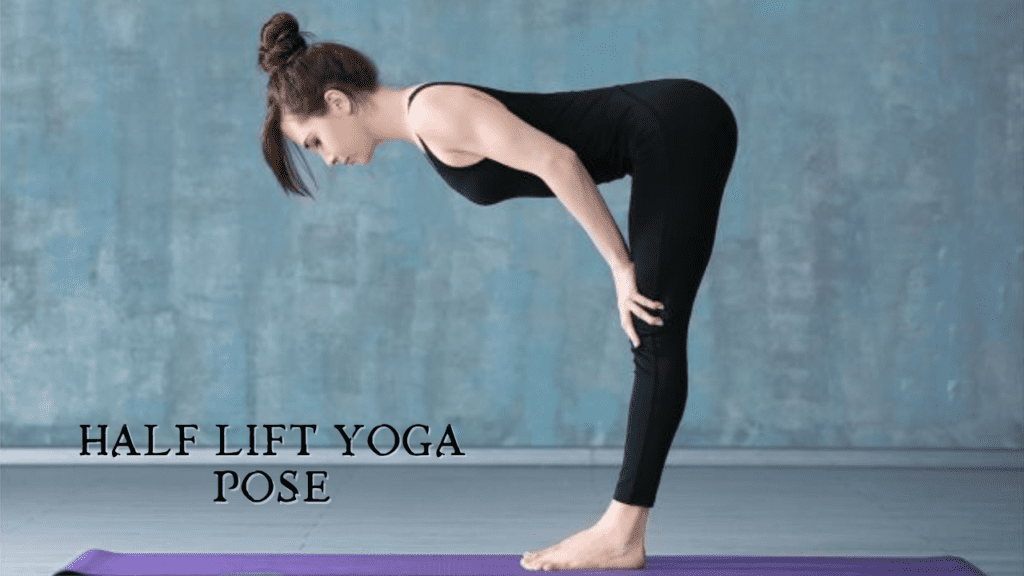Welcome to a deeper exploration of the Half Lift Yoga Pose, also known as Ardha Uttanasana. This fundamental pose is not only a pivotal part of many yoga flows, such as the Sun Salutation, but it also offers numerous benefits that enhance both your physical and mental well-being. Let’s embark on this detailed journey to understand and perfect Ardha Uttanasana.

What is Half Lift Yoga Pose
Ardha Uttanasana translates from Sanskrit as the “Half Intense Stretch Pose.” It’s a transitional pose that helps prepare your body for more intense stretches and poses. Positioned typically between the standing forward bend and the return to standing, it helps to warm up the body, making your muscles more pliable for the practice ahead.
Step-by-Step Execution of Half Lift
- Starting Position: Begin in a forward fold with your feet hip-width apart. This starting position helps decompress your spine and stretch your hamstrings.
- Lifting Action: As you inhale, lift your torso up until it is parallel to the floor. This action activates your core and stretches your spine.
- Hand Placement: Your fingertips can either rest on the floor, on yoga blocks for extra support, or on your shins. This flexibility in hand placement allows for adaptation based on individual flexibility and comfort.
- Spinal Alignment: Ensure that your back is flat, mimicking a tabletop, which enhances the spinal alignment and prepares you for more complex poses.
- Eye Focus: Maintain a neutral neck and gaze downwards to a point on the floor, which helps in maintaining balance and focus.
Benefits of Ardha Uttanasana
- Physical Posture Improvement: Regular practice strengthens the back muscles and aligns the spine, contributing to better posture.
- Hamstring Flexibility: It stretches the hamstrings gently, which can alleviate tightness and support mobility.
- Mental Clarity: This pose requires focus, which can help clear your mind and reduce stress.
- Preparation for Advanced Yoga: It builds foundational strength and flexibility for more complex poses.
Curious about more yoga poses? Check out our detailed guide on “Lion Yoga Pose(Simhasana)” for another enriching addition to your practice!
Detailed Tips for Mastery
- Core Engagement: To support your lower back, keep your core muscles engaged throughout the pose.
- Breath Coordination: Coordinate your movements with your breaths, inhaling as you lift, which helps increase focus and steadiness in the pose.
- Knee Position: If you have tight hamstrings, bending your knees slightly can help maintain a straight back, reducing strain.
Common Mistakes and Remedies
- Overarching the Lower Back: This common mistake can lead to discomfort. Focus on lengthening your torso forward rather than down to keep the spine neutral.
- Straining the Neck: Aligning your head with your spine instead of looking forward helps prevent neck strain.
Psychological Benefits
Focusing on your body’s position and breath can turn Ardha Uttanasana into a meditative practice, reducing anxiety and promoting a sense of inner peace.
Curious about more yoga poses? Check out our detailed guide on “Stargazer Yoga Pose” for another enriching addition to your practice!
Safety First: Contraindications and Precautions
- Lower Back Issues: Individuals with lower back problems should approach this pose with caution and consult with a healthcare provider or a yoga instructor for personalized modifications.
- Pregnancy: Pregnant women should modify the pose to avoid too much forward bending, possibly using a chair for support.
Modifications to Suit Every Practitioner
- For Tight Hamstrings: Place hands on yoga blocks or a chair to reduce the stretch intensity and gradually work on flexibility.
- For Extra Stability: If balancing is challenging, perform the pose with your back against a wall to learn proper alignment without the risk of falling.
The Role of Breath in Ardha Uttanasana
In yoga, breathwork is as important as physical posture. In Ardha Uttanasana, focus on deep, steady breaths that help you maintain the pose longer and with greater stability. This integration of breath and movement also enhances concentration and mental clarity.
Advanced Variations for Seasoned Yogis
- Arm Extensions: Extend your arms parallel to the ground, challenging your balance and strengthening your shoulders and back.
- Dynamic Movement: Incorporate a flow by alternating between Ardha Uttanasana and a forward fold, which enhances dynamic flexibility and control.
Curious about more yoga poses? Check out our detailed guide on “Bicycle Yoga Pose” for another enriching addition to your practice!
Using Props for Enhanced Practice
- Yoga Blocks: Utilize blocks under your hands if the floor feels too far away. This modification allows you to experience the pose’s benefits without overstretching.
- Straps: If you can’t easily reach your toes or shins, a strap can help maintain alignment without compromising form.
Conclusion
- Builds a Strong Foundation: It prepares your body for more challenging poses by strengthening and aligning.
- Accessible and Adaptable: With various modifications available, it’s a pose that can grow with your yoga practice.
- Promotes Holistic Health: It not only benefits your body but also calms your mind, making it a comprehensive exercise for well-being.
The Half Lift Yoga Pose is a gateway to a more balanced, flexible, and focused life. Have you noticed changes in your posture or flexibility since incorporating Ardha Uttanasana into your routine? Let’s discuss and share tips for deepening this practice!